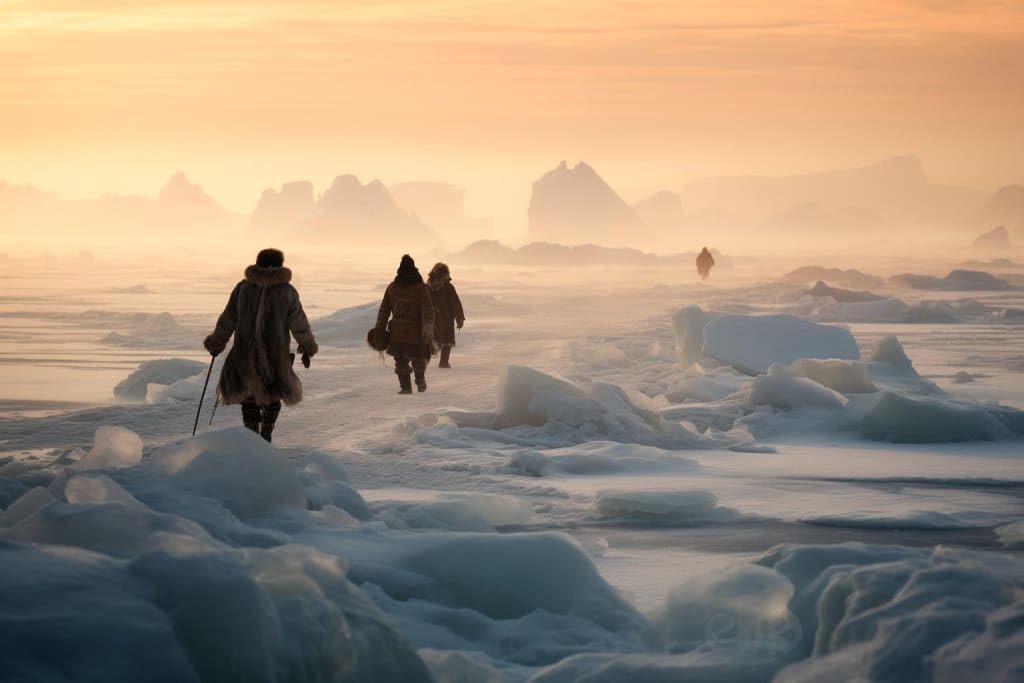Unlocking the Mysteries of Early Human Migration to North America: The Sea Ice Highway
North America's first people may have arrived by sea ice highway as early as 24,000 years ago

The timing and routes of the first human migrations to North America have long been debated in the field of archaeology. While the conventional theory suggests a land route through an ice-free corridor around 13,000 years ago, recent archaeological and genetic discoveries challenge this narrative. This article explores a groundbreaking theory presented at the American Geophysical Union Annual Meeting, proposing that early Americans might have traveled along a "sea ice highway" along the Pacific Coast.
The Pacific Coast Migration Theory:
Recent findings, including 23,000-year-old human footprints in New Mexico, hint at an earlier human presence in North America. Instead of the traditional ice-free corridor route, researchers suggest that these early inhabitants may have journeyed along the Pacific coastline from Beringia, the ancient land bridge between Asia and North America.
Sea Ice as a Pathway:
Presenting at the AGU23, researchers discuss paleoclimate reconstructions of the Pacific Northwest, shedding light on the possibility of a sea ice pathway. The concept of early Americans navigating the Pacific Coast is not entirely new, with evidence of coastal settlements in western Canada dating back to 14,000 years ago.
Climate Conditions and the Sea Ice Highway:
To understand the viability of the sea ice highway, scientists analyzed climate proxies in ocean sediment, focusing on the Pleistocene epoch. Climate models revealed that ocean currents were twice as strong as today during the last glacial maximum, making boat travel challenging. However, the presence of winter sea ice until around 15,000 years ago could have provided a platform for early Americans.
Implications and Future Research:
While proving sea ice migration remains challenging due to submerged archaeological sites, this theory offers a fresh perspective on how humans may have entered North America without a land bridge. The sea ice highway theory is not mutually exclusive with other migration routes, as conditions along the coastal route may have been conducive to migration between 24,500 and 22,000 years ago and 16,400-14,800 years ago.
Conclusion:
As researchers continue to explore the mysteries of early human migration, the sea ice highway theory presents a compelling alternative to traditional narratives. The study underscores the complexity of ancient human ingenuity, suggesting that multiple migration routes and methods may have played a role in populating North America.
Challenges in Establishing the Sea Ice Highway:
Proving the sea ice highway hypothesis faces significant challenges, primarily because many potential archaeological sites are now submerged underwater. Despite these obstacles, researchers are optimistic about the potential for underwater archaeology and advanced technologies to unveil evidence supporting the sea ice migration theory. The tantalizing prospect of discovering remnants of ancient human activity beneath the waves adds an extra layer of excitement to this evolving narrative.
The Adaptive Nature of Early Humans:
The sea ice highway theory highlights the adaptability and resourcefulness of early humans. Just as contemporary Arctic communities traverse sea ice on dog sleds and snowmobiles, early Americans might have harnessed the frozen expanses as pathways for travel and hunting marine mammals. This adaptation underscores the intricate relationship between ancient humans and their environment, showcasing their ability to exploit natural features for survival.
A Window into Ancient Climate Conditions:
The research presented by Summer Praetorius and her colleagues not only contributes to our understanding of early human migration but also provides insights into the climate conditions of the Pleistocene epoch. By examining climate proxies in ocean sediment, scientists can reconstruct ocean temperatures, salinity, and sea ice cover, offering a glimpse into the challenges and opportunities that shaped the paths of our ancestors.
Collaborative Efforts in Unraveling the Past:
The quest to uncover the truth about early human migration requires collaborative efforts across various scientific disciplines. Researchers, archaeologists, climatologists, and marine scientists must work hand in hand to piece together the puzzle of our prehistoric past. The interdisciplinary nature of this research is evident in the diverse range of experts attending the AGU23 conference, where insights from different fields converge to enrich our understanding of human history.
Future Directions and Remaining Questions:
As the sea ice highway theory opens up new avenues of exploration, numerous questions remain unanswered. How did early Americans navigate and adapt to the challenges posed by sea ice travel? What specific archaeological evidence might be hidden beneath the waves, waiting to be discovered? These questions fuel the curiosity of scientists and underscore the ongoing nature of research in unraveling the mysteries of human migration.
In conclusion, the sea ice highway theory challenges conventional ideas about the routes early humans took to populate North America. By considering the dynamic nature of ancient climates and the resourcefulness of early human populations, researchers continue to reshape our understanding of our prehistoric roots. As the journey into our past unfolds, the sea ice highway stands as a testament to the ever-evolving narrative of human history.
About the Creator
Nada soliman
You will read about the facts of countries, animals, and many things in our lives. You will listen a lot. Visit us now






Comments
There are no comments for this story
Be the first to respond and start the conversation.